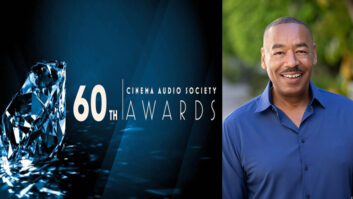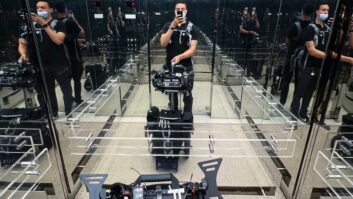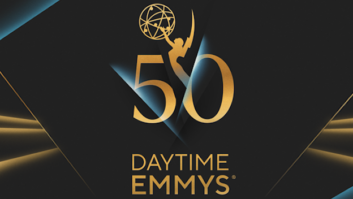Holding down the sound at the Governors’ Ball are (l-r): Christian Berry, Trace Goodman, Mark Montgomery, Chris Sorem, Randy Sinner, Paul Whittington. LOS ANGELES, CA—For the sixth year running, Goodman Audio Services provided sound production for September’s Primetime Emmys Governors Ball—and the Primetime Creative Arts Emmy Awards party one week prior—at the L.A. Convention Center. The ball, which hosts 3,800 guests, is marketed as “the largest formal dinner in America” by the Academy of Television Arts and Sciences, but it’s the shape of the stage, not the size of the event, that posed the biggest challenge to Goodman Audio.

“It’s a rotating stage; they like to make it as difficult as possible!” laughs Trace Goodman, president, Goodman Audio Services, which specializes in high-profile entertainment and corporate events. “And it has a dance floor immediately around the stage.”
Full-service event planning, design and production company Sequoia Productions once again engaged Goodman’s services for the ball.
In order to cover the donut-shaped dance floor, constructed in the center of the convention center’s 80,000-sq.-ft. West Hall, Goodman flew 18 EAW NTL720 active compact line array boxes in a ring directly above. EAW JF60 two-way boxes were positioned every four feet behind the material covering the front wall of the circular bandstand in the center, “just to bring imaging down to the stage,” he says. “And we have subs built into the side; we don’t have any subs for the [dining and seating] area, because we want the thump here [on the dance floor], not out there.”
Six hangs of QSC Audio Wide- Line-10 line arrays—four arrays of eight plus two of six; 44 in total— were positioned above the outer perimeter of the stage to cover the rest of the hall. “People are mingling and talking about their trophies, so it’s really important that they can hear, but still have a party atmosphere at the same time,” he says. A few delay speakers provided coverage in the shadows behind the vast “Enchanted Forest”-themed structures, with one also positioned above the entrance: “So they get hit with the party sound right off the bat.”
Four amp racks in the catwalks powered the WideLine boxes. “Everything runs through the EAW Unet system, and all of the audio is on Cat 5. We’re Cat 5 to the stage, and we’re Cat 5 to all the speaker systems.”
Onstage monitoring for the Red Hot Band, featuring Australian Idol finalist Jessica Mauboy, comprised an Aviom system for the players with wireless in-ears for the vocalists. “We have a Yamaha PM5D that we park by the stage for the soundcheck. Once soundcheck is over, it moves back and sits next to front of house.”
Riedel’s RockNet handled signal distribution between the stage and FOH, also over Cat 5. “Even the Aviom is all Cat 5. Our biggest mult is an eight-pair on this show.”
Having custom-mounted RockNet 100 series 16×8 I/O panels into a collection of portable racks, “we can set them as a stage box or stack them on their sides like a regular splitter system,” says Goodman. “We also use the Riedel Performer comms system, their P/L.”
An assortment of RF equipment located inside the central hub of the revolving stage handled the wireless mics and in-ears. “We’ve got something like 52 frequencies for the show: mics, comm and in-ears,’ says Goodman, including a Shure Axiom wireless microphone management system plus multiple channels of Sennheiser ew300 IEM.
“One of the vocalists for the band likes to have talkback,” he also reports. Although the additional Axient Talk Switch—which allows the singer to communicate privately with an engineer— adds a little physical length to the mic transmitter, he says, “She loves it.”
In previous years, a Goodman Audio monitor engineer would walk the dance floor and interact with the musicians, controlling the Yamaha M7CL console with an iPad. This year, with the change to Aviom monitor mixing, the M7CL was moved to front of house, having run out of card slots to interface with the system. “And I can’t really hook the iPad up to a 5D,” he observes.
Although the rotating stage, which turned through 360 degrees before reversing direction, was a challenge, the duration of the load-in and setup was perhaps more of a test. “It’s probably the longest load-in that I have had for any show; we started on the 6th, and we load out on the 23rd,” he says.
“The ring has to get up out of the way, be cabled and tied off, so they can build the stage. Amp racks and power distros have to come in early. The main PA I can put up much later, and front of house and all the stuff on the ground comes in later. You’ve got to wait for all of these things to get done before you get to the next step. This all should only take a day!”
Goodman Audio Services
goodmanaudio.com






